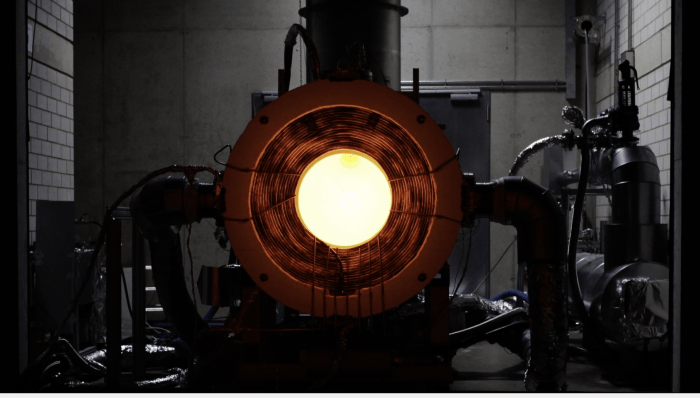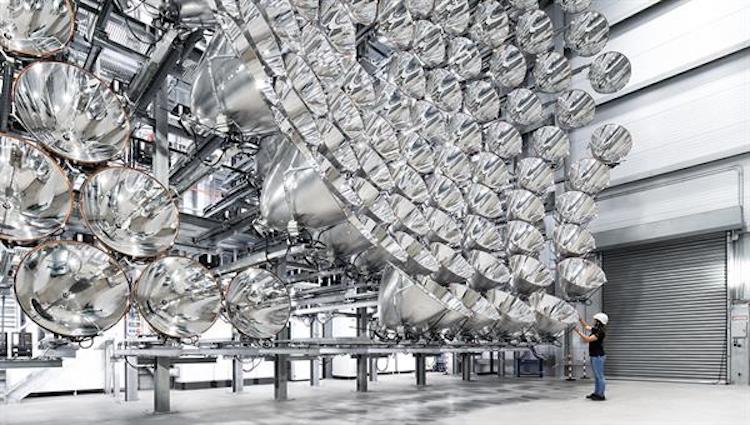Thermochemical Oxygen Pumping with Perovskite Reticulated Porous Ceramics for Enhanced Reduction of Ceria in Thermochemical Fuel Production Abstract: Within this work, reticulated monolithic foams and granules made from CaMnO3 − δ and strontium substituted variations are demonstrated to significantly improve the performance of a water splitting redox oxide when employed as a thermochemical oxygen pumping material. …
Published at Energy – Analysis of heat and mass transfer in a porous solar thermochemical reactor
IMAGE©Synhelion – solar heat for industry Abstract: Solar thermochemistry shows great potential as a viable solution for addressing the challenge of energy storage. The design of the reactor is still challenging the development and rapid upscaling of solar thermal conversion and storage processes. This study presents a novel reactor capable of gas reheating and develops …
SolarPACES Conference 2024 – First Announcement and Call for Papers
SolarPACES 2024 First Announcement SolarPACES (Solar Power and Chemical Energy Systems) is pleased to announce the 2024 Conference to be held from October 8-11, 2024, in Rome, Italy. SolarPACES is the premier international network advancing research, development, and commercial deployment of concentrating solar thermal technologies. This year, we will be in Italy, where history and modernity go hand in …
Continue reading “SolarPACES Conference 2024 – First Announcement and Call for Papers”
Over 90% efficient energy storage improved by flowing heat round two pebble layers
The iterations of the design for the packed bed layered radial thermal energy storage: View full size An over 90% efficient thermal storage technology from KTH gets further refinements Energy storage will become essential to fully replace fossil fuels for industrial heat and the electric grid. Batteries are a cost-effective solution when electricity is needed as …
Published at Industrial & Engineering Chemistry Research – Solar Thermochemical Production of Syngas from H2O and CO2─Experimental Parametric Study, Control, and Automation
Abstract: We report on an experimental parametric study performed on a modular and fully automated solar fuel system for the solar-driven thermochemical splitting of CO2 and H2O. Concentrated solar energy is used as the source of high-temperature process heat for effecting a ceria-based redox cycle, producing syngas with a tailored H2/CO ratio. We determine the influence …
DOE’s $30 million funding to advance solar fuels from concentrated solar
Solar Energy Technologies Office The U.S. Department of Energy (DOE) Solar Energy Technologies Office (SETO) announced its intent to fund the Concentrating Solar Flux to Heat and Power funding opportunity, which will award up to $30 million for innovative projects that accelerate the large-scale development and deployment of concentrating solar-thermal power (CSP) technology. CSP technologies …
Continue reading “DOE’s $30 million funding to advance solar fuels from concentrated solar”
Published at Applied Energy – A review of solar thermochemical cycles for fuel production
Abstract: Solar-driven CO2/H2O splitting via a two-step solar thermochemical cycle is a promising approach for fuel production and carbon neutrality to address the intermittent instability and low energy density of solar energy while taking advantage of its clean and nonpolluting nature. However, current experimental efficiencies are still below theoretical levels due to various limitations such …
DLR Research Position: Recycling potential of production units for solar fuels
PhD process engineering, chemical engineering, environmental engineering or similar (f/m/x) Starting date immediately Duration of contract 3 years Remuneration up to German TVöD 13 Type of employment Part-time The vision of the DLR Institute for Future Fuels is to develop technological solutions that enable the cost-effective production of fuels, hydrogen, or even commodities in the …
Continue reading “DLR Research Position: Recycling potential of production units for solar fuels”
Japan to pay 15 years cost difference to birth green hydrogen technologies
Methane Pyrolysis in a Liquid Metal Bubble Column Reactor [CfD or Contracts-for-Difference subsidies pay the difference between an entrenched energy technology and a newly developing one to bring down those costs till it has scaled-up. CfD policies in the UK for its first decade of offshore wind jumpstarted widespread deployment and resulting cost reductions.] Source: …
Continue reading “Japan to pay 15 years cost difference to birth green hydrogen technologies”
A solar sulphur cycle to make unlimited thermal energy storage
Sulfur can be stored like a pile of coal. “This cycle allows you to get energy out of the sulphur and store it in between. Why it’s in focus now is that we can use 100% renewable energy – concentrated solar – to heat the reaction. That’s why chemical companies now come in and are …
Continue reading “A solar sulphur cycle to make unlimited thermal energy storage”











